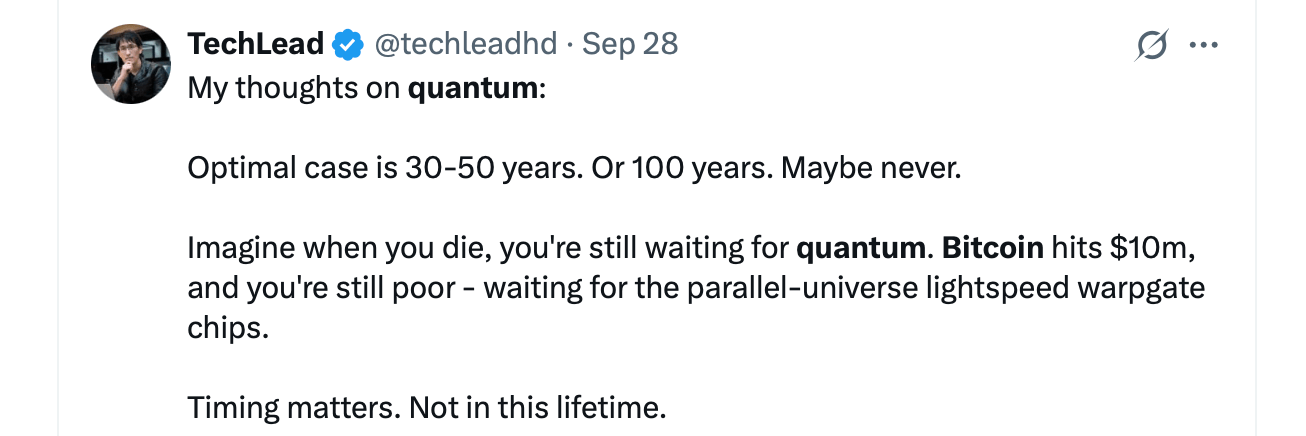The HRF report, “The Quantum Threat to Bitcoin,” explores how advances in quantum computing could undermine Bitcoin’s foundational cryptography. Google researchers recently revealed a breakthrough allowing a quantum computer to perform operations 13,000 times faster than a classical supercomputer — an achievement HRF says should prompt early preparation.
Although experts differ on when CRQCs will emerge, HRF cites growing concern that such machines could appear within the next five years. These systems, capable of breaking Bitcoin’s elliptic curve cryptography, could potentially seize millions of bitcoin locked in early address formats or target unconfirmed transactions. The foundation calls post-quantum preparedness “a human rights imperative,” stressing that activists relying on bitcoin ( BTC) could lose critical financial privacy and safety if the network isn’t fortified.

According to HRF’s findings, approximately 6.51 million bitcoin — nearly one-third of the total supply, worth more than $718 billion — could be exposed to long-range quantum attacks. Of this, 1.72 million bitcoin (roughly $188 billion) sit in dormant or lost wallets that may never migrate to safer, quantum-resistant addresses.
The report identifies two key risk categories:
- Long-range attacks exploit old or reused public keys, such as those in pay-to-public-key (P2PK) and taproot (P2TR) addresses.
- Short-range attacks could hijack transactions while they await confirmation, letting attackers derive private keys in real time.
The HRF authors highlight an emerging moral and political rift within the Bitcoin community: whether to “burn” unclaimed, vulnerable coins to prevent theft or “do nothing” and allow quantum attackers to seize them. The debate cuts to Bitcoin’s ideological roots — balancing censorship resistance against proactive defense.
The report cites comments from developers, including Bitcoin Improvement Proposal (BIP) 360 author Hunter Beast, who argues that freezing coins undermines Bitcoin’s neutrality, and Lightning Network developer Olaoluwa Osuntokun, who warns it could amount to forced wealth redistribution.
To safeguard against future attacks, HRF discusses two primary paths: lattice-based and hash-based signature schemes, both considered quantum-resistant. However, these cryptographic methods would significantly enlarge transaction data — potentially 10 to 38 times current sizes — posing scalability and governance challenges.
Bitcoin Improvement Proposal 360 offers one potential framework, introducing taproot address upgrades that accommodate multiple quantum-safe algorithms. HRF stresses that implementing such solutions will require broad coordination, education, and community consensus, echoing the years-long debates over Segwit and block-size upgrades.
Beyond technical hurdles, HRF emphasizes the human consequences of inaction. Dissidents and journalists depend on Bitcoin to bypass state surveillance and financial repression. A quantum breach could expose their transactions, compromise privacy, and even endanger lives. HRF says adapting Bitcoin for the quantum era must remain “inclusive, accessible, and resilient,” keeping human rights at the forefront of protocol design.
The foundation plans to use its Bitcoin Development Fund to sponsor further research into post-quantum cryptography, testnets, and migration tooling. HRF also aims to foster education and dialogue through events and publications focused on quantum resilience and Bitcoin’s long-term security.
While HRF and others view preparation as essential, many researchers believe that fears of an imminent quantum attack on Bitcoin have been overstated. Theoretical breakthroughs in quantum computing have yet to overcome immense engineering and stability hurdles. Running Shor’s algorithm at the scale needed to break Bitcoin’s elliptic curve cryptography would require tens of millions—if not billions—of stable, error-corrected qubits, far beyond today’s capabilities.

Still, to many, the theoretical threat is real and worth addressing with sober analysis. Bitcoin’s open-source nature, long-term adaptability, and strong economic incentives to defend the network suggest that any transition to quantum-resistant cryptography will have to be deliberate, transparent, and very much community-driven. Most experts broadly agree that Bitcoin’s shift toward post-quantum security will unfold as a managed evolution—not an overnight crisis—mirroring how past upgrades were introduced.
- What is the HRF “Quantum Threat to Bitcoin” report about?
The HRF report examines how future quantum computers could compromise Bitcoin’s encryption and endanger millions of coins. - How much bitcoin could be at risk?
The report estimates roughly 6.5 million bitcoin, valued at more than $700 billion, could be vulnerable to quantum attacks. - When might these threats materialize?
Experts suggest cryptographically relevant quantum computers could emerge within five to 20 years. - What steps is HRF taking next?
HRF plans to fund quantum-resilient cryptographic research through its Bitcoin Development Fund and related initiatives.
免责声明:本文章仅代表作者个人观点,不代表本平台的立场和观点。本文章仅供信息分享,不构成对任何人的任何投资建议。用户与作者之间的任何争议,与本平台无关。如网页中刊载的文章或图片涉及侵权,请提供相关的权利证明和身份证明发送邮件到support@aicoin.com,本平台相关工作人员将会进行核查。




